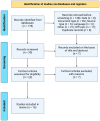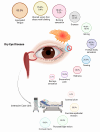Understanding the Dry Eye Disease-Related Symptoms in South America: Prevalence and Associated Factors-A Systematic Review
- PMID: 39458010
- PMCID: PMC11508735
- DOI: 10.3390/jcm13206060
Understanding the Dry Eye Disease-Related Symptoms in South America: Prevalence and Associated Factors-A Systematic Review
Abstract
Background/Objectives: Dry eye disease is a leading cause of ophthalmologic consultations worldwide and can significantly impact quality of life. While global prevalence rates vary widely, data specific to South America are limited. This systematic review aims to describe and analyze the prevalence and associated factors of dry eye disease-related symptoms in South American populations. Methods: Following Preferred Reporting Items for Systematic Reviews and Meta-Analyses (PRISMA) guidelines, a systematic review was conducted using databases such as PubMed, Web of Science, Scopus, and LILACS. Primary studies in English and Spanish that examined the prevalence of dry eye disease-related symptoms in South American populations and its associated factors were included without date restrictions. Studies were screened and selected based on predefined inclusion and exclusion criteria, resulting in the final inclusion of 16 studies from six South American countries. Results: This review identified significant variability in the prevalence of dry eye disease-related symptoms in South American populations in the region, ranging from 4% to 77.5%, with a mean prevalence of 39.3%. Higher prevalence rates were observed among specific groups, such as university students (58.6%) and administrative workers (57.9%). Factors associated with dry eye disease-related symptoms in South American populations included female sex, older age, prolonged screen time, insufficient sleep, and medical conditions such as hypertension, connective tissue disorders, and the use of medications like antihypertensives and antidepressants. Conclusions: The prevalence of dry eye disease-related symptoms in South American populations is notably higher than global averages, highlighting regional challenges. This study emphasizes the need for standardized diagnostic tools and comprehensive epidemiological research across South America, particularly in underrepresented countries, to inform public health strategies tailored to the specific needs of these populations.
Keywords: South America; associated factors; dry eye disease; prevalence.
Conflict of interest statement
The authors declare no conflicts of interest.
Figures



References
-
- McCann P., Abraham A.G., Mukhopadhyay A., Panagiotopoulou K., Chen H., Rittiphairoj T., Gregory D.G., Hauswirth S.G., Ifantides C., Qureshi R., et al. Prevalence and Incidence of Dry Eye and Meibomian Gland Dysfunction in the United States. JAMA Ophthalmol. 2022;140:1181–1192. doi: 10.1001/jamaophthalmol.2022.4394. - DOI - PMC - PubMed
Publication types
LinkOut - more resources
Full Text Sources

